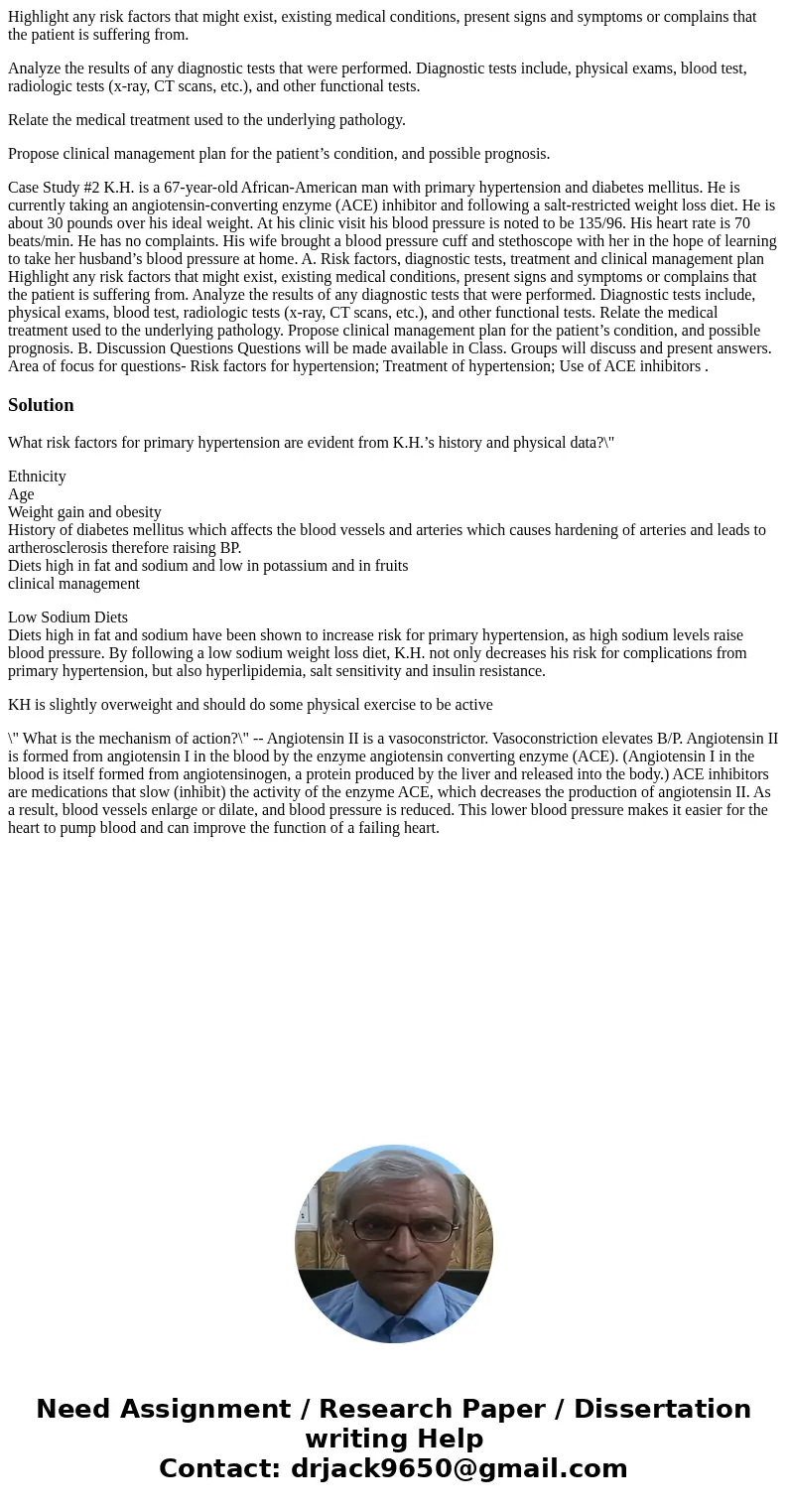Highlight any risk factors that might exist existing medical
Highlight any risk factors that might exist, existing medical conditions, present signs and symptoms or complains that the patient is suffering from.
Analyze the results of any diagnostic tests that were performed. Diagnostic tests include, physical exams, blood test, radiologic tests (x-ray, CT scans, etc.), and other functional tests.
Relate the medical treatment used to the underlying pathology.
Propose clinical management plan for the patient’s condition, and possible prognosis.
Case Study #2 K.H. is a 67-year-old African-American man with primary hypertension and diabetes mellitus. He is currently taking an angiotensin-converting enzyme (ACE) inhibitor and following a salt-restricted weight loss diet. He is about 30 pounds over his ideal weight. At his clinic visit his blood pressure is noted to be 135/96. His heart rate is 70 beats/min. He has no complaints. His wife brought a blood pressure cuff and stethoscope with her in the hope of learning to take her husband’s blood pressure at home. A. Risk factors, diagnostic tests, treatment and clinical management plan Highlight any risk factors that might exist, existing medical conditions, present signs and symptoms or complains that the patient is suffering from. Analyze the results of any diagnostic tests that were performed. Diagnostic tests include, physical exams, blood test, radiologic tests (x-ray, CT scans, etc.), and other functional tests. Relate the medical treatment used to the underlying pathology. Propose clinical management plan for the patient’s condition, and possible prognosis. B. Discussion Questions Questions will be made available in Class. Groups will discuss and present answers. Area of focus for questions- Risk factors for hypertension; Treatment of hypertension; Use of ACE inhibitors .
Solution
What risk factors for primary hypertension are evident from K.H.’s history and physical data?\"
Ethnicity
Age
Weight gain and obesity
History of diabetes mellitus which affects the blood vessels and arteries which causes hardening of arteries and leads to artherosclerosis therefore raising BP.
Diets high in fat and sodium and low in potassium and in fruits
clinical management
Low Sodium Diets
Diets high in fat and sodium have been shown to increase risk for primary hypertension, as high sodium levels raise blood pressure. By following a low sodium weight loss diet, K.H. not only decreases his risk for complications from primary hypertension, but also hyperlipidemia, salt sensitivity and insulin resistance.
KH is slightly overweight and should do some physical exercise to be active
\" What is the mechanism of action?\" -- Angiotensin II is a vasoconstrictor. Vasoconstriction elevates B/P. Angiotensin II is formed from angiotensin I in the blood by the enzyme angiotensin converting enzyme (ACE). (Angiotensin I in the blood is itself formed from angiotensinogen, a protein produced by the liver and released into the body.) ACE inhibitors are medications that slow (inhibit) the activity of the enzyme ACE, which decreases the production of angiotensin II. As a result, blood vessels enlarge or dilate, and blood pressure is reduced. This lower blood pressure makes it easier for the heart to pump blood and can improve the function of a failing heart.

 Homework Sourse
Homework Sourse